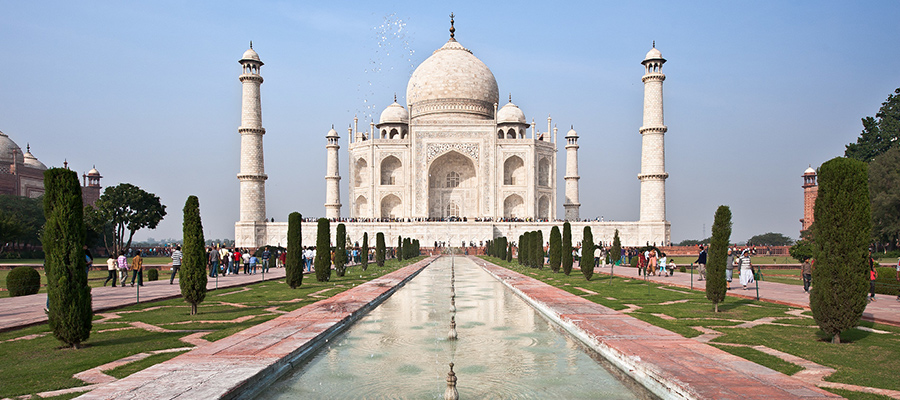Golden Triangle Tour with Varanasi
![]() Duration : 08 Nights / 09 Days
Duration : 08 Nights / 09 Days
![]() Destinations : Delhi - Jaipur - Agra - Varanasi
Destinations : Delhi - Jaipur - Agra - Varanasi
Day - 1Arrival
At the airport, you will see that Aryabhatt Tour And Travels representative is waiting to give a warm welcome and later he will escort you to your hotel, previously reserved. After upon arrival in Hotel discuss your tour itinerary with our representative in Lobby and after that our representative will help you to check in formalities. Overnight at Hotel.
Delhi - The capital of kingdoms and empires is now a sprawling metropolis with a fascinating blend of the past and the present. Delhi is a perfect introduction to the composite culture of an ancient History.
Day - 2Delhi Sightseeing
Morning After breakfast start your Full day city tour of old and new Delhi visit Jama Mosque:- is the largest mosque in India. Where 25000 Thousand people can pray at a time. Total length of the mosque is 40 Meters and Width is 27 Meters. The Mosque was built by Mughal Emperor Shah Jahan. Than Enjoy the By Cycle Rickshaw Ride in Old Delhi Through the narrow lane. Now these are 3-wheel cycles with a sofa seat at the back. The Rickshawalla (Rickshaw driver) sits on a small cushion in the front and two passengers on the sofa seat behind. This is a remarkable way to explore and picture the hustle and bustle as well as the color of the narrow winding streets bursting with people and pavement shops selling wares of all description - including a laughing set of dentures. The ride would be accompanied by peals of laughter both from the passengers as well as the onlookers. Drive Pass Red Fort: - Build by Mughal Emperor Shah Jahan. It was started built in 1639 A.D and completed in 1648 A.D. Then Visit the Raj Ghat Where Mahtama Gandhi was cremited.Where you can see eternal flame is burning. India Gate:-The towering archway of India Gate the center of New Delhi is a war memorial, built in memory of the Indian soldiers who lost their lives fighting for the British Army in World War I. Then drive pass all the government Building like Parliament House, President Place. Visit Humayun’s Tomb:-The tomb was commissioned by his First wife name Haji Begum. It was the first of this type of Mughal architecture to be built in The tomb is part of a greater complex that's set amongst beautiful gardens. Which is Known as Charbagh(Four-square). In 1993 A.D it was declared as World Heritage Site. Qutub Minar:-QutabMinar also spelled as Qutab Minar or Qutb Minar the tallest brick minaret in the world, is an incredible example of early Indo–Islamic architecture. Total height of minar is 73 Meters. It was built in 11192 A.D The tower has five distinct stories, and is covered with intricate carvings and verses from the holy Quran. There are also a number of other historic monuments on the site.Laxmi Narayan Temple:-Built in 1938 A.D.is known as Birla Mandir was built by Jugal Kishore Birla, it is one of the major temples in Delhi. The temple is dedicated to Goddess Laxmi and her consort Narayana. The temple was inaugurated by Mahatma Gandhi on the stipulation that people of all castes shall be allowed to enter the Temple.Stay overnight at Hotel in Delhi.
Day - 3Delhi - Jaipur
After breakfast proceed to Jaipur. The origins of the beautiful city can be traced back to the eighteenth century, during the reign of Jai Singh II who ascended the Amber throne in 1699. Jaipur today, the spirit of Rajputana. In-spite of growing into a bustling metropolis, it still retains its character and history - A beautiful fusion of the and modernity. It is popularly known as the Pink City because of the extensive use of the locally abundant pink plastered stone, Jaipur thrills the soul with its massive forts, magnificent palaces. After check in Hotel have some rest and start city tour of Jaipur On arrival check in Hotel later start City tour of Jaipur visit City Palace, which was built by Maharaja Swai Jai Singh II in 1729 A.D.till 1732 A.D, Jantar Mantar (observatory), it was built in 1734 AD. By the Sawai Jai Singh II, a great astronomer. By means of the instruments, where astronomer could measure the position stars and calculate eclipses. Where you can see the world's largest stone sundial. It is also a UNESCO World Heritage site. Wind Palace, “The Hawa Mahal” design for ladies of the Royal house hold to watch the going to the street while theme self-remaining hidden for the public view. Stay overnight at Hotel in Jaipur.
Day - 4Jaipur
Early morning after breakfast start city Tour of Jaipur.Visit the majestic Amber Fort with color full painted Elephant / Jeep (Subject to Availability / Permission by the local administration) - the ancient capital of the state until 1728. The Ambar fort complex stands amidst weeded hill overlooking Delhi Jaipur highway one of the finest examples of Rajput architecture, it was the ancient capital of the kachhawah ruler. The origin place was built by Raja Mansingh and addition were made later by Sawai Jai Singh. When the place Are Diwan-e – Aam or the “Hall of Public Audience”, Diwan – e – Khas or the “Hall of private Audience” and the Sukhniwas where a cool breeze blows across channels of water for the purpose of air conditions. There is also the Jai Mandir or the “Temple of Victory”, with its famed sheesh mahal, the scintillating “Hall of Mirrors”. On a way back to city Photo stop at “Summer Palace” which is known as Jal Mahal. Jaigarh Fort:- Is Standing on a hilltop, overlooking the palaces and city of Amer. The world’s biggest cannon on wheels- the Jai Ban is positioned here, built during reign of Maharaja Sawai Jai Singh II in1726 A.D.Nahargarh Fort:- It stands on the edge of the Aravalli Hills.Cresting a hill about 600 ft. above the city, the fort was built in 1734 A.D. It was Built by Maharaja Swai Jai Singh . The walls of the fort run along the ridge and within are architectural beauties like HawaMandir and MadhvendraBhawan.
Galtaji (Monkey Temple): -This holy Hindu pilgrimage Centre.Temple was built by Diwan Rao Kriparam an attendant to Swai jai Singh II.in 18 th century. TheGalati Temple is located in the Aravalli hills. The temple dedicated to the Sun God (Which is the only one of its kind in this part of the country) and natural spring. Stay overnight at hotel in Jaipur.
Day - 5Jaipur - Agra
After breakfast proceed to Agra en route visit.
Fatehpur Sikri : Its Means “The City of Victory”. It Was Built by Akbar, the Mughal emperor in 1570 A.D, the city was a tribute to Sufi Saint.It is also UNESCO site in 1986 A.D. FatehpurSikri is a perfect blend of Indo Islamic and Persian architecture. For around 10 years, the city remained the capital of Mughal Empire. The city was founded in 1571 A.D.Entire fort is made of local Red Sand Stone. It houses some of the city’s important buildings namely BulandDarwaza, Birbal’s House, PanchMahal and Jama Masjid.
Later drive to Agra.Upon arrival check in Hotel. Stay overnight at Hotel in Agra.
Day - 6Agra - Varanasi (By Train)
Early Morning at sunrise visit the Taj Mahal. Its mean “Crown of the palaces”.
The construction of Taj Mahal started in 1643 A.D. and It was completed in 1653 A.D.You cannot think of Agra without visiting TajMahal. Taj Mahal is made of white marble. It was constructed by Shah Jahan in memory of his beloved wife, MumtazMahal. The monument stands proof for the brilliance of Mughal architecture. It has been declared as World Heritage Site in the year 1983 A.D. After that back to hotel and have your breakfast and check out. And start your city tour. Visit Agra Fort :Agra Fort is a historical fort.It was started built in 1565 A.D.and it was completed in 1573A.D.It is also UNESCO site in 1983 A.D. The 16th century monument is yet another proof of the architectural brilliance of Mughals. The fortress comprises many palaces namely, Jahangir Palace, KhasMahal Diwan E Am. There are publicaudience halls and two mosques. Visit Itmad-ud-Daulah:-
It is also known as “Baby Taj”.The tomb was built by Nur Jahan the wife of Jahangir in the memory of her father .In India’s it is first tomb to be made completely out of white marble. It was constructed during Jahangir’s period. The 21-meter high tomb was constructed in memory of MirzaGhiyas, who was the father-in-law of Jahangir.It means pillar of the state. The wall paintings inside are sheer beauty to view.
Later in the Evening transfer to Railway station to board Train to Varanasi. Stay overnight in 2nd Aircon sleeper Train.
Day - 7Varanasi
Early Morning on arrival at Varanasi Railway Station meet and greet our representative later transfer to Hotel. Varanasi is also known as “Benares”or “Kashi”.The city draws Hindu pilgrims who take bath in the holy Ganges River. City is dedicated to the Hindu God Lord Shiva. Later in the afternoon start a city tour of Varanasi visitAnnapoorna Devi Temple:A It is one of the most famous Hindu Temple in the holy city of Varanasi. Annapurna or Annapoorna is the Hindu Goddess of nourishment. Anna means food and grains. Purna means full, complete or full.She is form of Mata Parvati. The most well-known temple dedicated to Goddess Annapurna is in Varanasi. Adjacent to the Sanctum of the Goddess is the KasiViswanath temple. In the Temple in the afternoon food offerings to the Goddess are distributed to the elderly and disabled every day.
Assi Ghat : Assi Ghat, the Ghat located near of Assi River and the holy Ganges, is the southernmost Ghat in Varanasi. The Ghat is renowned for a spectacular and large Shiva Lingam placed under a Peepal Tree. This is a favorite spot for Hindu devotees to offer their prayers to Lord Shiva after taking holy dip in the river.This religiously important place got its reference in many hindu puranas, including MatsyaPurana, KurmaPurana, Agni Purana and Padma Purana. Legendary stories.
Kashi Vishwanath Temple : KashiVishwanath Temple is one of the most famous Hindu temples dedicated for Lord Shiva. the Holiest Place of Hindus (and center of earth in Hindu Cosmology) where at least once in life a Hindu is expected to do pilgrimage and if possible pour the remains (ashes) of cremated ancestors here on the River Ganges. Later in the evening enjoy the Ganga Aarti .Stay overnight at Hotel in Varanasi.
Day - 8Varanasi
After breakfast start city tour visitSarnath it is 10 km away from Varanasi. It is one of the four most significant Buddhist pilgrimage places in India; Sarnath is the place where Lord Buddha first covey his lecture after attaining "nirvana".The deer park in sarnath is where Gautama Buddha first taught the Dharma.It is an important pilgrimage site for Buddhist.
Sarnath Buddhist Temple:-There are a number of 20 century Buddhist temples in Sarnath.Lord Buddha preached his first sermon at a deer park. Many of these Buddhist Temples in Sarnath are built and maintained by monks from Sir lanka Tibet, China and Japan but the main Buddhist temple is the MulagandhakutiVihar. The main shrine (vihara) it is called the Mulagandakuti, is said to be located at the place where Buddha used to stay during his visits to Sarnath. In the MulagandhakutiVihara there also is a Buddha walk.The recent 'MulagandhakutiVihara' or the modern Buddhist temple is 110 feet high with an image of Buddha inside it. There are also fine paintings on the walls of this temple by Japanese artist KosetsuNosu. Sarnath Museum:-Sarnath Museum is the oldest museum of Archaeological Survey of India.The museum has 6832 sculptures and artefacts. The museum has rich collection of sculptures, artifacts and edifices comprising numerous Buddha. While the single most famous exhibit of this museum is the Lion Capital of Asoka, the Sarnath museum has a small but awe-inspiring collection of Buddhist artifacts. Among the things to see is a beautiful sculpture of the Buddha from the fifth century. Also worth exploring are several beautiful figures of the bodhisattvas. The main attraction of the Sarnath Archaeological Museum is the superb Ashoka Pillar. It has four back-to-back lions, which has been adopted as the National symbol of India. On way back visitBanaras Hindu University:-Banaras Hindu University (BHU), is a Central College.It was established in 1916 A.D. By Pandit Madan Mohan Malaviya .which is also the largest residential university in Asia where 30000 students living on its campus. BHU was founded in 1916 by PanditMadan Mohan Malviya. The campus spread over 1300 acres (5.5 km?) campus was built on land donated by then KashiNaresh. It has 140 teaching departments and more than 75 hostels for boys and girls.It is the first university in India. Several of its colleges, including engineering (IT-BHU), science, linguistics, journalism and mass communication, law and medicine (IMS-BHU), Faculty of Management Studies, are ranked amongst the best in India.Bharat Mata Temple :-Bharat Mata Mandir means “Mother India Temple”, a fairly new temple built in 1936 and located at Kashi Vidyapith Campus, This temple was built in 1936 A.D.by the freedom fighter Babu Shiv Prasad Guptaand was inaugurated by Mahatma Gandhi. a fine three dimensional structure of undivided India. The marble structure, rather a map of India, is constructed at the right proportions of oceans, lands and hills. This is a unique temple and a symbol of patriotism. The temple is in the shape of pentagonal cone with five pillars supporting the structure.Later in After noon transfer to airport to board the flight for Delhi.Upon arrival in Delhi meet our representative and transfer to Hotel.Overnight at Hotel in Delhi.
Day - 9Varanasi - Delhi Day leisure (By Train)
In this day transfer to Airport to board the flight to your onward destination.
Tour End but memories remains always. Best of India Tours
Best of India Tours
 Special Interest Tours
Special Interest Tours

















